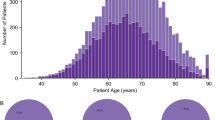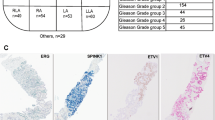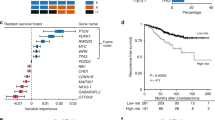Abstract
New predictive markers for managing prostate cancer are urgently required because of the highly variable natural history of this disease. At the time of diagnosis, Gleason score provides the gold standard for assessing the aggressiveness of prostate cancer. However, the recent discovery of TMPRSS2 fusions to the ERG gene in prostate cancer raises the possibility of using alterations at the ERG locus as additional mechanism-based prognostic indicators. Fluorescence in situ hybridization (FISH) assays were used to assess ERG gene status in a cohort of 445 prostate cancers from patients who had been conservatively managed. The FISH assays detected separation of 5′ (labelled green) and 3′ (labelled red) ERG sequences, which is a consequence of the TMPRSS2–ERG fusion, and additionally identify interstitial deletion of genomic sequences between the tandemly located TMPRSS2 and ERG gene sequences on chromosome 21. Cancers lacking ERG alterations exhibited favourable cause-specific survival (90% survival at 8 years). We identify a novel category of prostate cancers, characterized by duplication of the fusion of TMPRSS2 to ERG sequences together with interstitial deletion of sequences 5′ to ERG (called ‘2+Edel’), which by comparison exhibited extremely poor cause-specific survival (hazard ratio=6.10, 95% confidence ratio=3.33–11.15, P<0.001, 25% survival at 8 years). In multivariate analysis, ‘2+Edel’ provided significant prognostic information (P=0.003) in addition to that provided by Gleason score and prostate-specific antigen level at diagnosis. Other individual categories of ERG alteration were associated with intermediate or good prognosis. We conclude that determination of ERG gene status, including duplication of the fusion of TMPRSS2 to ERG sequences in 2+Edel, allows stratification of prostate cancer into distinct survival categories.
This is a preview of subscription content, access via your institution
Access options
Subscribe to this journal
Receive 50 print issues and online access
$259.00 per year
only $5.18 per issue
Buy this article
- Purchase on Springer Link
- Instant access to full article PDF
Prices may be subject to local taxes which are calculated during checkout






Similar content being viewed by others
References
Adolfsson J, Steineck G, Hedlund PO . (1997). Deferred treatment of clinically localized low-grade prostate cancer: actual 10 year and projected 15 year follow up of the karolinska series. Urology 50: 722–726.
Albertsen PC, Fryback DG, Storer BE, Kolon TF, Fine J . (1995). Long term survival among men with conservatively treated localized prostate cancer. JAMA 274: 626–631.
Albertsen PC, Hanley JA, Barrows GH, Penson DF, Kowakczyk PD, Sanders MM et al. (2005). Cancer and the Will Rogers phenomenon. J Natl Cancer Inst 97: 1248–1253.
Allsbrook Jr WC, Mangold KA, Johnson MH, Lane RB, Lane CG, Amin MB et al. (2001a). Interobserver reproducibility of gleason grading of prostatic carcinoma: urologic pathologists. Hum Pathol 32: 74–80.
Allsbrook Jr WC, Mangold KA, Johnson MH, Lane RB, Lane CG, Epstein JI . (2001b). Interobserver reproducibility of gleason grading of prostatic carcinoma: general pathologist. Hum Pathol 32: 81–88.
Bill-Axelson A, Holmberg L, Ruutu M, Haggman M, Anderson SO, Bratell S et al. (2005). Radical prostatectomy versus watchful waiting in early prostate cancer. N Engl J Med 352: 1977–1984.
Bostwick DG, Foster CS . (1999). Predictive factors in prostate cancer: current concepts from the 1999 college of American pathologists conference on solid tumor prognostic factors and the 1999 world health organization second international consultation on prostate cancer. Semin Urol Oncol 17: 222–272.
Chism DB, Hanlon AL, Troncoso P, Al Saleem T, Horwitz EM, Pollack A . (2003). The gleason score shift: score four and seven years ago. Int J Radiat Oncol Biol Phys 56: 1241–1247.
Chodak GW, Thisted RA, Gerber GS, Johansson JE, Adolfsson J, Jones GW et al. (1994). Results of conservative management of clinically localized prostate cancer. N Engl J Med 330: 242–248.
Clark J, Merson S, Jhavar S, Flohr P, Edwards S, Foster C S et al. (2007). Diversity of TMPRSS2-ERG fusion transcripts in the human prostate. Oncogene 26: 2667–2673.
Cox DR, Oakes D . (1984). Analysis of Survival Data. Chapman & Hall: London, New York.
Cuzick J, Fisher G, Kattan MW, Berney D, Oliver T, Foster CS et al. (2006). Long-term outcome among men with conservatively treated localised prostate cancer. Br J Cancer 95: 1186–1194.
Demichelis F, Fall K, Perner S, Andren O, Schmidt F, Setlur SR et al. (2007). TMPRSS2:ERG gene fusion associated with lethal prostate cancer in a watchful waiting cohort. Oncogene; epub ahead of publication, 22 Janurary.
Foster CS . (2000). Pathology of benign prostatic hyperplasia. Prostate Suppl 9: 4–14.
Foster CS, Bostwick D G, Bonkhoff H, Damber J E, van der K T, Montironi R et al. (2000). Cellular and molecular pathology of prostate cancer precursors. Scand J Urol Nephrol Suppl 205: 19–43.
Foster CS, Falconer A, Dodson AR, Norman AR, Dennis N, Fletcher A et al. (2004). Transcription factor E2F3 overexpressed in prostate cancer independently predicts clinical outcome. Oncogene 23: 5871–5979.
Hermans KG, van Marion R, van Dekken H, Jenster G, van Weerden W M, Trapman J . (2006). TMPRSS2:ERG fusion by translocation or interstitial deletion is highly relevant in androgen-dependent prostate cancer, but is bypassed in late-stage androgen receptor-negative prostate cancer. Cancer Res 66: 10658–10663.
Holmberg L, Bill-Axelson A, Helgesen F, Salo JO, Folmerz P, Haggman M et al. (2002). A randomised trial comparing radical prostatectomy with watchful waiting in early prostate cancer. N Engl J Med 347: 781–789.
Iljin K, Wolf M, Edgren H, Gupta S, Kilpinen S, Skotheim R I et al. (2006). TMPRSS2 fusions with oncogenic ETS factors in prostate cancer involve unbalanced genomic rearrangements and are associated with HDAC1 and epigenetic reprogramming. Cancer Res 66: 10242–10246.
Johansson JE, Andren O, Anderson SO, Dickman PW, Holmberg L, Magnuson A et al. (2004). Natural history of early localised prostate cancer. JAMA 291: 2713–2719.
Lambros MB, Simpson PT, Jones C, Natrjan R, Westbury C, Steele D et al. (2006). Unlocking pathology archives for molecular genetic studies: a reliable method to generate probes for chromogenic and fluorescent in situ hybridisation. Lab Invest 86: 398–408.
Melia J, Moseley R, Ball RY, Griffiths DF, Grigor K, Harnden P et al. (2006). A UK-based investigation of inter- and intra-observer reproducibility of gleason grading of prostatic biopsies. Histopathology 48: 644–654.
Nam RK, Sugar L, Wang Z, Yang W, Kitching R, Klotz LH et al. (2007). Expression of TMPRSS2 ERG gene fusion in prostate cancer cells is an important prognostic factor for cancer progression. Cancer Biol Ther epub ahead of publication, 2 January.
Oyama T, Allsbrook Jr WC, Kurokawa K, Matsuda H, Segawa A, Sano T et al. (2005). A comparison of interobserver reproducibility of gleason grading of prostatic carcinoma in Japan and the United States. Arch Pathol Lab Med 129: 1004–1010.
Perner S, Demichelis F, Beroukhim R, Schmidt FH, Mosquera JM, Setlur S et al. (2006). TMPRSS2:ERG fusion-associated deletions provide insight into the heterogeneity of prostate cancer. Cancer Res 66: 8337–8341.
Smith EB, Frierson Jr HF, Mills SE, Boyd JC, Theodorescu D . (2002). Gleason scores of prostate biopsy and radical prostatectomy specimens over the past 10 years: is there evidence for systematic upgrading? Cancer 94: 2282–2287.
Soller MJ, Isaksson M, Elfving P, Soller W, Lundgren R, Panagopoulos I . (2006). Confirmation of the high frequency of the TMPRSS2/ERG fusion gene in prostate cancer. Genes Chromosomes Cancer 45: 717–719.
Tomlins SA, Mehra R, Rhodes DR, Smith LR, Roulston D, Helgeson BE et al. (2006). TMPRSS2:ETV4 gene fusions define a third molecular subtype of prostate cancer. Cancer Res 66: 3396–3400.
Tomlins SA, Rhodes DR, Perner S, Dhanasekaran SM, Mehra R, Sun XW et al. (2005). Recurrent fusion of TMPRSS2 and ETS transcription factor genes in prostate cancer. Science 310: 644–648.
van der Kwast TH, Ciatto S, Martikainen PM, Hoedemaeker R, Laurila M, Pihl CG et al. (2006). Detection rates of high-grade prostate cancer during subsequent screening visits. Results of the european randomized screening study for prostate cancer. Int J Cancer 118: 2538–2542.
Wang J, Cai Y, Ren C, Ittmann M . (2006). Expression of variant TMPRSS2/ERG fusion messenger RNAs is associated with aggressive prostate cancer. Cancer Res 66: 8347–8351.
Yao SL, Lu-Yao G . (2002). Understanding and appreciating overdiagnosis in the PSA era. J Natl Cancer Inst 94: 958–960.
Yoshimoto M, Joshua AM, Chilton-Macneill S, Bayani J, Selvarajah S, Evans AJ et al. (2006). Three-color FISH analysis of TMPRSS2/ERG fusions in prostate cancer indicates that genomic microdeletion of chromosome 21 is associated with rearrangement. Neoplasia 8: 465–469.
Acknowledgements
This work was funded by Cancer Research UK, National Cancer Research Institute, a specialized program of Research Excellence grant from US National Cancer Institute, Grand Charity of Freemasons, Rosetrees Trust, The Bob Champion Cancer Trust, The Orchid Appeal and David Koch Foundation. Funding bodies had no involvement in the design and conduct of the study, or in collection management, analysis and interpretation of the data or in preparation, review or approval of the manuscript. We thank Christine Bell and Sandra Edwards for help in typing the manuscript and preparing figures and tables.
Author information
Authors and Affiliations
Consortia
Corresponding author
Rights and permissions
About this article
Cite this article
Attard, G., Clark, J., Ambroisine, L. et al. Duplication of the fusion of TMPRSS2 to ERG sequences identifies fatal human prostate cancer. Oncogene 27, 253–263 (2008). https://doi.org/10.1038/sj.onc.1210640
Received:
Revised:
Accepted:
Published:
Issue Date:
DOI: https://doi.org/10.1038/sj.onc.1210640
Keywords
This article is cited by
-
Acquired copy number variation in prostate tumours: a review of common somatic copy number alterations, how they are formed and their clinical utility
British Journal of Cancer (2024)
-
Race and prostate cancer: genomic landscape
Nature Reviews Urology (2022)
-
Early-onset metastatic and clinically advanced prostate cancer is a distinct clinical and molecular entity characterized by increased TMPRSS2–ERG fusions
Prostate Cancer and Prostatic Diseases (2021)
-
Comprehensive metabolomics analysis of prostate cancer tissue in relation to tumor aggressiveness and TMPRSS2-ERG fusion status
BMC Cancer (2020)
-
Focal therapy for localized prostate cancer in the era of routine multi-parametric MRI
Prostate Cancer and Prostatic Diseases (2020)



